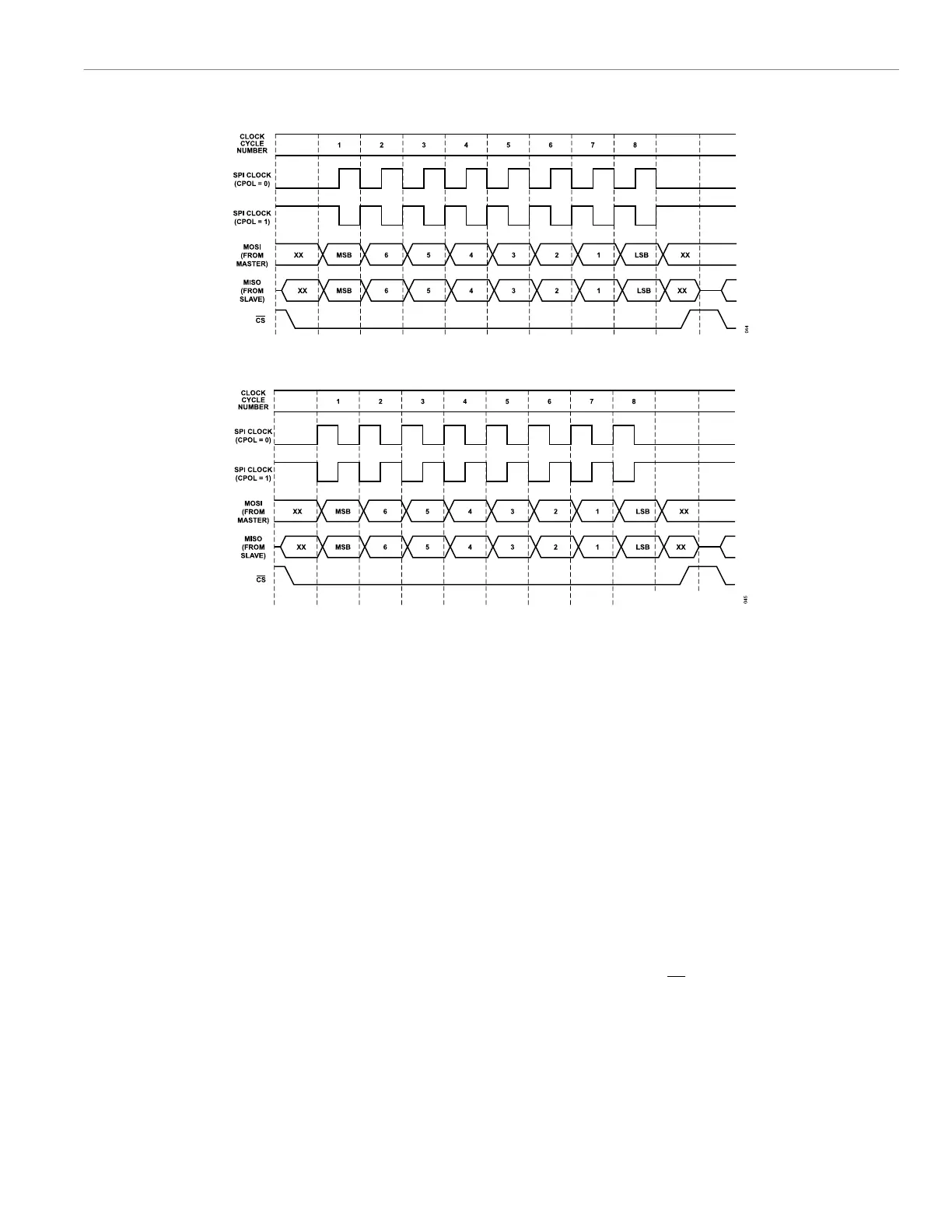Reference Manual ADuCM356
SERIAL PERIPHERAL INTERFACES
analog.com Rev. A | 239 of 312
Figure 61. SPI Transfer Protocol, CPHA = 0
Figure 62. SPI Transfer Protocol, CPHA = 1
Transfers in Target Mode
In target mode, a transfer is initiated by the assertion of the chip
select of the device. Though the initiator can support up to four
chip select output lines, only one chip select input is used in target
mode. The device as a target transmits and receives 8-bit data until
the transfer is concluded by the deassertion of chip select. The SPI
transfer protocol diagrams in Figure 61 and Figure 62 illustrate the
data transfer protocol for the SPI, and the effects of SPIx_CTL, Bit
2 and SPIx_CTL, Bit 3 on that protocol. The chip select must not be
tied to the ground.
SPI Data Underrun and Overflow
If the transmit zeros enable bit (SPIx_CTL, Bit 7) is cleared, the last
byte from the previous transmission is shifted out when a transfer is
initiated with no valid data in the FIFO. If SPIx_CTL, Bit 7 is set to
1, 0s are transmitted when a transfer is initiated with no valid data
in the FIFO. If the receive overflow overwrite enable bit (SPIx_CTL,
Bit 8) is set, and there is no space left in the FIFO, the valid data
in the receive FIFO is overwritten by the new serial byte received. If
SPIx_CTL, Bit 8 is cleared, and there is no space left in the FIFO,
the new serial byte received is discarded. When SPIx_CTL, Bit 8
is set, the contents of the SPI receive FIFO are undefined, and its
contents must be discarded by user code.
Full Duplex Operation
Simultaneous reads and writes are supported on the SPI. When im-
plementing full duplex transfers in initiator mode, use the following
procedure:
1. Initiate a transfer sequence via a transmit on the P0.1/
SPI0_MOSI pin and the P1.3/SPI1_MOSI pin. Set SPIx_CTL,
Bit 6 = 1. If interrupts are enabled, interrupts are triggered when
a transmit interrupt occurs but not when a byte is received.
2. If using interrupts, the SPI transmit interrupt indicated by
SPIx_STAT, Bit 5 or the transmit FIFO underrun interrupt
(SPIx_STAT, Bit 4) is asserted approximately three to four SPI
clock periods into the transfer of the first byte. If necessary,
reload a byte into the transmit FIFO by writing to the SPIx_TX
register.
3. The first byte received via the MISO pin does not update the
receive FIFO status bits (SPIx_FIFO_STAT, Bits[11:8]) until 12
SPI clock periods after CS goes low. Therefore, two transmit
interrupts can occur before the first receive byte is ready to be
processed.
4. After the last transmit interrupt occurs, it may be necessary to
read two more bytes. It is recommended that SPIx_FIFO_STAT,
Bits[11:8] be polled outside of the SPI interrupt handler after the
last transmit interrupt is handled.
